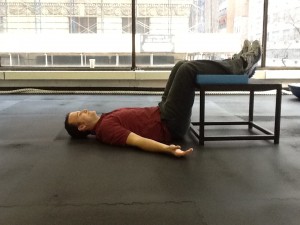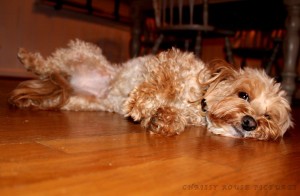When prescribing home exercises for my patients I often try to keep it to a minimum of 3 exercises. I understand it’s the last thing people want to do at the end of a long day, especially when they require great effort and concentration. Luckily for those of us that experience pain and discomfort there is an exercise that is easy to perform, doesn’t require a great deal of mental energy, and gravity does all the work for you.
This exercise (seen below) has been called many different things and has been claimed to be an innovative technique by many different people. But the truth is that people have been putting their feet up at the end of the day long before any clinician could coin it as their own. While each individual may have a different rationale and name for this exercise, the principle and basis are the same regardless.

The world’s easiest postural restoration exercise (aka 90-90 position, constructive rest, static back)
Rationale
- Allows for passive re-alignment of spine and posture (Pete Egoscue)
- Decreases the tension of the psoas muscle to allow for “constructive rest” (Liz Koch)
- Puts the low back in the position of the least load on the discs
- Reduction of lumbar lordosis
- Increases the posterior separation between the vertebrae and facet joints
- Reduces pressure on the nerves
How to Perform
- Lie on ground
- Put feet up (on an ottoman, chair, coffee table, dog, significant other, etc.)
- Make sure your hips and knees are at 90-90
- Aim for 15-20 minutes per session
- Enjoy
Cognitive Connection
Many practitioners advocate conscious awareness of your body in this position (e.g. where do you feel pressure? tension? stress?). Some believe this is also a great position to exercise your diaphragmatic breathing. Others recommend simply focusing on allowing your body to relax and to let your body adapt to gravity. Try a combination of these approaches to find what works best for you.
90-90 Position, Constructive Rest Position, Egoscue Static Back
References
Peterson MD, Nelson LM, McManus AC, et al. The effect of operative position on lumbar lordosis. A radiographic study of patients under anesthesia in the prone and 90-90 positions. Spine 1995 20(12):1419-24
Koch, Liz. The Psoas Book 2nd Edition. Guinea Pig Pubns, 1997.
—
The main reason I do this blog is to share knowledge and to help people become better clinicians/coaches. I want our profession to grow and for our patients to have better outcomes. Regardless of your specific title (PT, Chiro, Trainer, Coach, etc.), we all have the same goal of trying to empower people to fix their problems through movement. I hope the content of this website helps you in doing so.
If you enjoyed it and found it helpful, please share it with your peers. And if you are feeling generous, please make a donation to help me run this website. Any amount you can afford is greatly appreciated.



